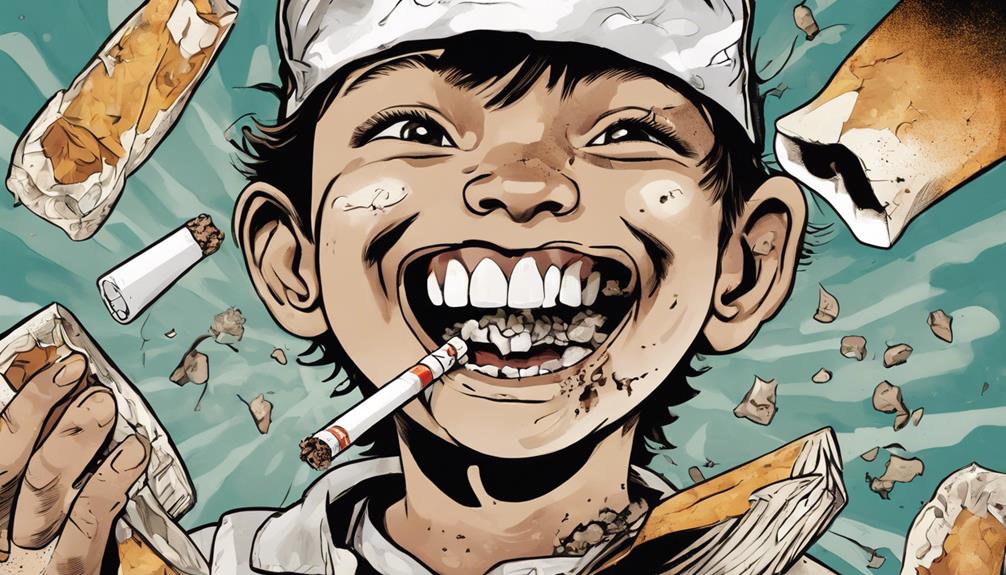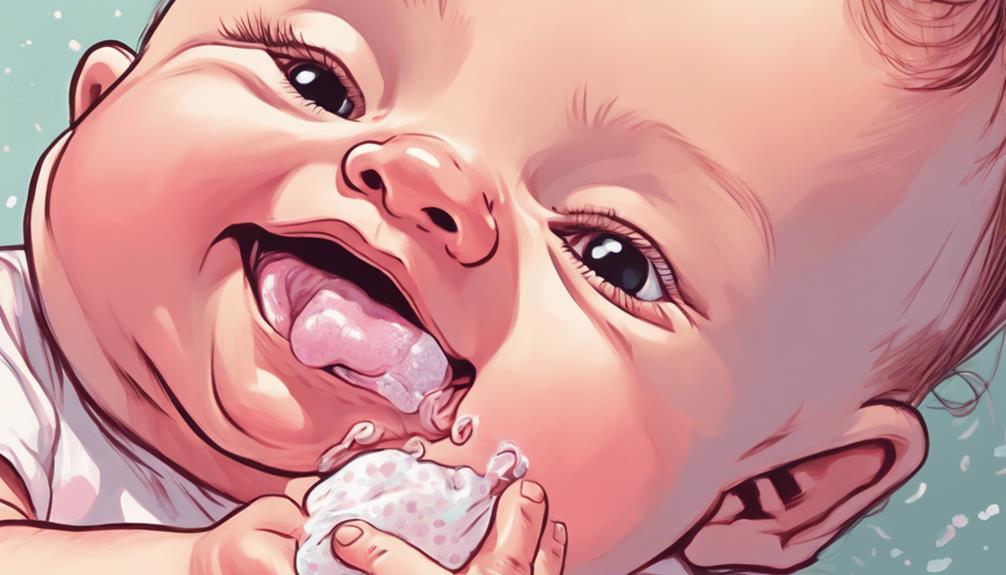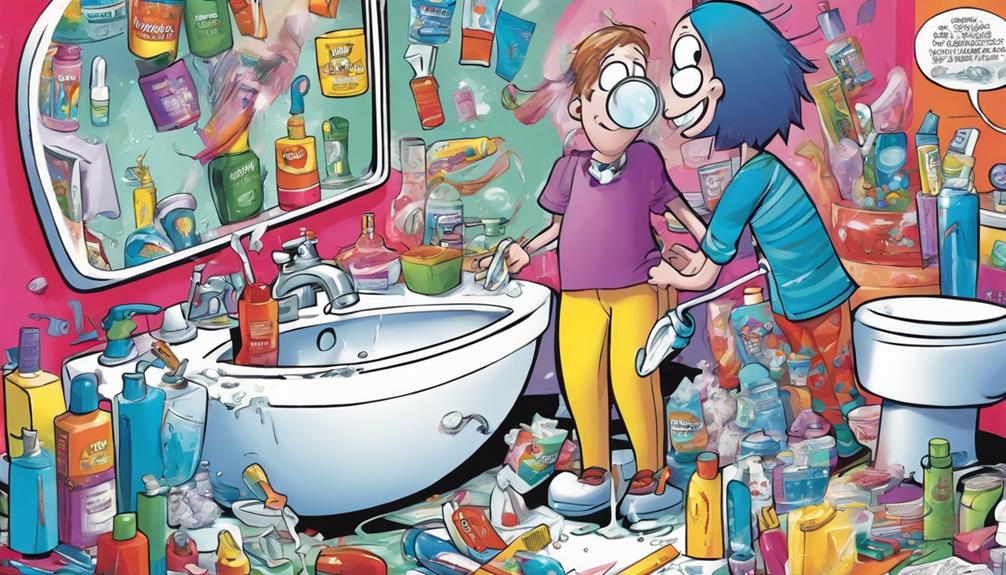Smoking can seriously damage your child's teeth, leading to cavities, gum disease, and even tooth loss. When kids are exposed to secondhand and thirdhand smoke, the harmful chemicals weaken their immune systems, making them more susceptible to dental issues. This can result in bad breath, tooth discoloration, and painful mouth sores. To protect their oral health, it's essential to create a smoke-free environment and educate them about the risks of smoking. Open conversations about the dangers can empower your children to make healthier choices. Discover more ways to safeguard their smiles and promote good oral habits.
Key Takeaways
- Secondhand smoke exposure increases children's risk of gum disease and tooth decay due to weakened immune responses and harmful chemical exposure.
- Thirdhand smoke leaves toxic residues that can lead to respiratory issues and other health problems as children explore contaminated surfaces with their mouths.
- Tobacco use significantly raises the likelihood of painful oral health issues, including swollen gums, bad breath, and tooth discoloration in children.
- Educating children about the dangers of smoking empowers them to resist peer pressure and understand the long-term consequences of tobacco use.
Overview of Smoking's Impact

Smoking's impact on kids' teeth is alarming, as even secondhand smoke can lead to serious oral health issues. When children are exposed to smoking, they face an increased risk of gum disease and tooth decay. The harmful chemicals found in tobacco weaken their immune response, making it easier for bacteria to thrive in their mouths. This bacterial growth can lead to cavities and other dental problems that affect their overall well-being.
Additionally, studies show that secondhand smoke can negatively influence the development of permanent teeth, causing malformations or discoloration. Kids living in environments with smokers are often more susceptible to these issues. You might also notice that children exposed to smoking frequently deal with bad breath and stained teeth, as the toxins linger in their surroundings.
It's essential to understand that these early exposures can lead to long-term dental problems. As a parent or caregiver, being aware of how smoking affects oral health can empower you to create a healthier environment. By taking action, you can help protect your child's smile and minimize their risk of gum disease and tooth decay.
The Role of Secondhand Smoke

Secondhand smoke poses a vital risk to children's oral health, leading to a range of detrimental effects on their teeth and gums. When kids are exposed to secondhand smoke, they absorb over 7,000 harmful chemicals that can weaken their immune system. This increased vulnerability makes them more susceptible to tooth decay and gum disease.
Research shows that children living with smokers are more likely to suffer from dental issues, including cavities and infections. The link between secondhand smoke and oral health problems is concerning, as these conditions can have long-lasting impacts on a child's overall well-being. Furthermore, the American Academy of Pediatrics warns that exposure to secondhand smoke can raise the risk of developing oral cancers later in life, adding to the urgency of the matter.
It's essential to protect your children from secondhand smoke, as there's no safe level of exposure. By creating a smoke-free environment, you can greatly reduce their risk of oral health problems and promote healthier teeth and gums. Taking these steps not only safeguards their present health but also helps guarantee a brighter, healthier future.
Understanding Thirdhand Smoke
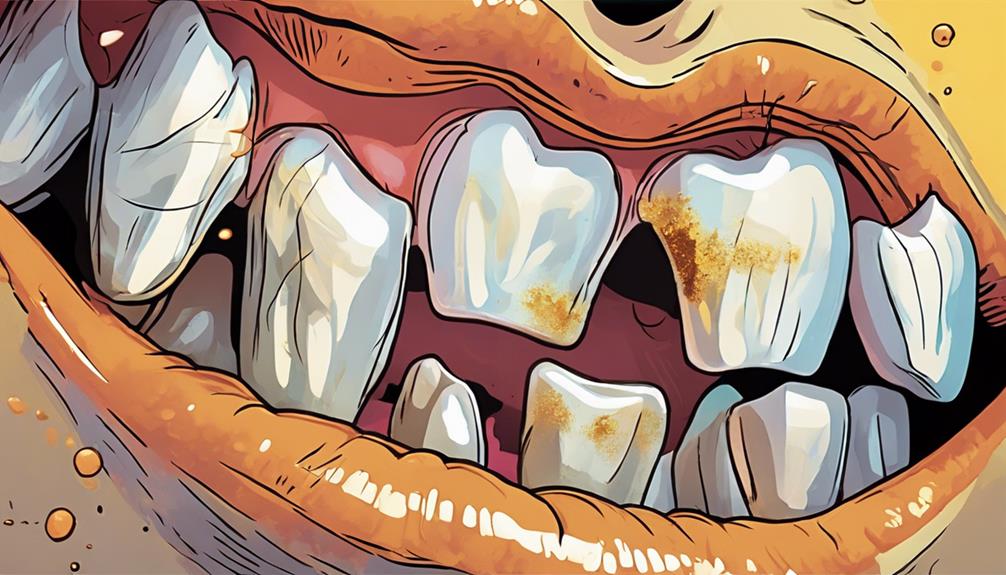
When you think about smoking's impact, don't forget about thirdhand smoke, which leaves harmful residues on surfaces.
Kids are especially at risk since they often touch contaminated areas and explore their surroundings with their mouths.
Once these harmful substances settle in your home, getting rid of them can be tough, emphasizing the importance of not smoking indoors.
Residue on Surfaces
Thirdhand smoke creates a hidden layer of toxic residue on surfaces and belongings, posing serious health risks, especially to children and pets. When tobacco is smoked, harmful chemicals, including nicotine, settle on walls, furniture, and even clothing. This residual thirdhand smoke can linger for months, making it difficult to eliminate completely.
As a caregiver, it's vital to recognize that children are particularly vulnerable to these toxins. Studies show that exposure to thirdhand smoke can lead to respiratory issues and increase the risk of developing asthma. The harmful substances in this residue can be absorbed through the skin or inhaled, contributing to potential oral health problems and other health risks similar to those caused by secondhand smoke.
To protect your children, consider implementing a smoke-free policy in your home and car. Regularly clean surfaces where smoke may have settled, and encourage smokers to change their clothes and wash their hands after smoking. Understanding the implications of thirdhand smoke is important for fostering a healthier environment for your family and preventing lasting damage to their health.
Risks for Children
Children face significant risks from exposure to thirdhand smoke, as harmful chemical residues can infiltrate their environment and impact their health. When adults smoke, these toxic substances settle on surfaces, clothing, and even in the air, creating a hazardous space for kids. You mightn't realize that thirdhand smoke can contain over 250 known toxicants, including carcinogens, which pose serious threats to your child's well-being.
Young children are particularly vulnerable because their bodies are still developing. They often spend more time on the floor, where these residues tend to accumulate. Exposure to thirdhand smoke can lead to respiratory illnesses, skin irritations, and even developmental issues. This is alarming, especially considering the impact on their oral health.
Smoking not only affects the environment but can also harm your child's teeth. The toxins in thirdhand smoke can contribute to dental problems, which can have long-lasting effects on their confidence and overall health.
It's vital to create a smoke-free environment for your children to protect their health and guarantee a brighter future for their teeth and overall well-being.
Difficult to Eliminate
Eliminating thirdhand smoke from your environment can be an intimidating task, as its invisible pollutants cling to surfaces and fabrics long after the smoke has cleared. These residues pose significant health risks, especially to children and pets, who are more vulnerable to harmful effects. Understanding the challenges of removing thirdhand smoke is essential for protecting your family.
To effectively tackle thirdhand smoke, consider these key points:
- Awareness: Recognize that thirdhand smoke exists and can linger in your home.
- Cleaning: Regularly clean surfaces and fabrics to reduce exposure to harmful residues.
- Education: Learn about the chemicals involved and their associated health risks.
- Ventilation: Improve airflow in your home to help dissipate any lingering smoke particles.
Tobacco Use and Oral Health
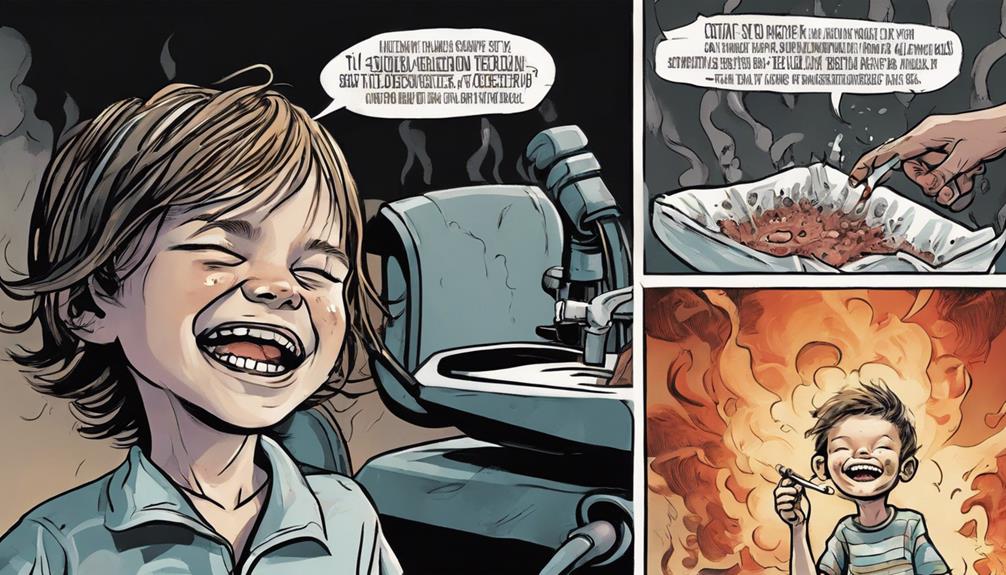
Tobacco use can wreak havoc on oral health, leading to serious issues like gum disease and tooth decay in young individuals. When children are exposed to smoking, whether firsthand or through secondhand smoke, they face a higher risk of developing oral health problems. The toxic chemicals in tobacco compromise their immune systems and contribute to harmful oral bacteria, increasing plaque buildup and leading to poor oral hygiene.
Additionally, smoking can cause painful mouth sores and ulcers in children, making eating difficult and uncomfortable. If you notice tooth discoloration or persistent bad breath in your child, consider the possibility of tobacco exposure, as these symptoms are often linked to smoking or secondhand smoke.
Moreover, early exposure to tobacco can set the stage for lifelong oral health issues, including an elevated risk of developing oral cancer later in life. It's essential to address these risks with your children, educating them about the dangers of tobacco and its lasting effects on their oral health.
Risks of Gum Disease
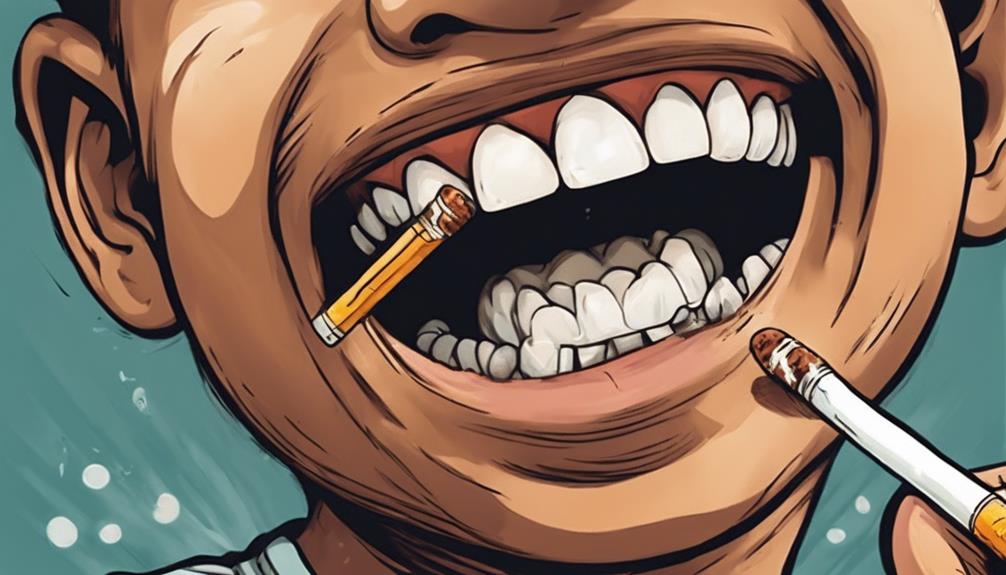
Exposure to smoking markedly heightens the risk of gum disease, as it weakens the immune response and makes it tougher for young bodies to combat infections affecting gum health. If your child is exposed to smoking, whether directly or through second-hand smoke, their oral health could be compromised in several ways:
- Increased likelihood of developing gum disease
- Higher prevalence of plaque and tartar buildup on teeth
- Potential progression from gingivitis to more severe periodontitis
- Greater risk of tooth loss if issues aren't addressed early
Gum disease in children can lead to serious consequences, including pain and difficulty eating. It's essential to recognize that children aren't just passive observers; they're actively affected by their environment.
You should have open conversations about the dangers of smoking and its impact on their teeth and gums. Encouraging healthy habits and regular dental visits can help safeguard their smiles.
Symptoms of Oral Health Issues
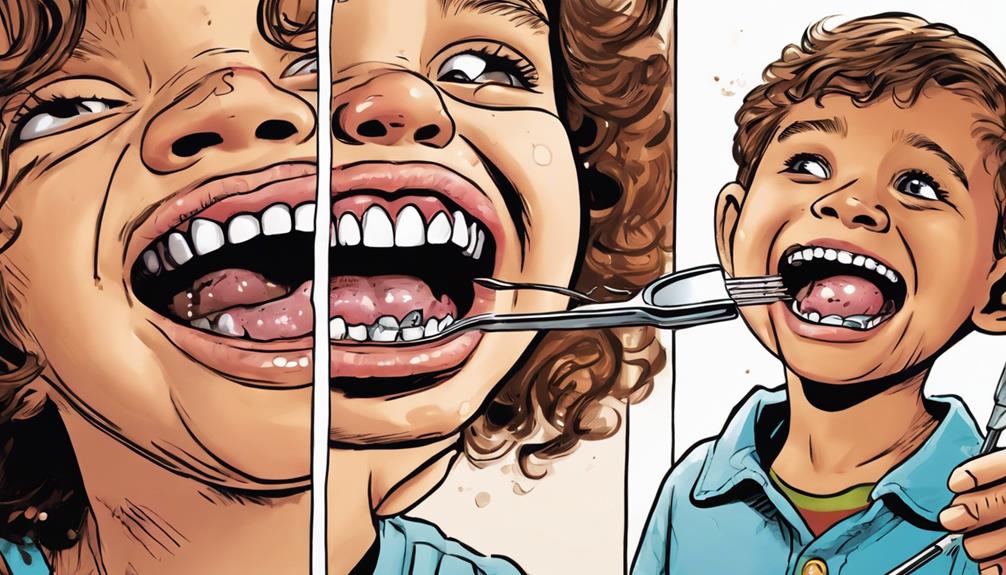
Recognizing symptoms of oral health issues early can make a significant difference in your child's overall well-being. You should keep an eye out for signs of gum disease, like swollen or bleeding gums, persistent bad breath, and loose teeth. These symptoms can worsen with exposure to secondhand smoke, which increases the risk of oral health problems.
While oral cancer is rare in children, it's vital to watch for persistent ulcers, unexplained swelling, or growths in the mouth. These symptoms warrant immediate attention from a dental professional. Additionally, children exposed to smoking may experience increased plaque buildup and tartar formation, leading to dental issues at an earlier age.
Regular dental check-ups are important for monitoring your child's oral health, especially if they might be exposed to tobacco smoke. Early detection of symptoms can prevent more serious issues down the line.
Prevention Strategies for Kids

To protect your kids' teeth from the dangers of smoking, start by educating them on proper oral hygiene.
Creating a smoke-free home environment is essential, too, as it shields them from harmful smoke exposure.
Educate on Oral Hygiene
Teaching kids proper oral hygiene habits helps them build a strong foundation for lifelong dental health.
By focusing on oral care, you can protect their teeth and gums from the harmful effects of smoking and other substances.
Here are some effective prevention strategies you can implement:
- Encourage daily brushing with fluoride toothpaste to combat tooth decay.
- Teach them to floss regularly, as it's essential for maintaining healthy gums.
- Schedule regular dental check-ups every six months to catch any issues early.
- Educate them about the negative impacts of smoking and vaping on oral health, empowering them to make healthier choices.
Encourage Smoke-Free Environments
Creating smoke-free environments is essential for protecting kids' health and promoting their well-being, especially when it comes to preventing the harmful effects of tobacco on their teeth and gums. Secondhand smoke can lead to respiratory issues and increase the risk of gum disease in children. By establishing smoke-free zones in homes and cars, you not only safeguard their health but also set a positive example for them to follow as they grow.
Educating parents about the dangers of smoking and its impact on oral health is key to fostering a commitment to maintaining smoke-free environments. When parents understand the risks associated with both secondhand and thirdhand smoke, they're more likely to create safe spaces for their children.
Community initiatives that promote smoke-free parks and public spaces further reinforce this message, ensuring that children can play and thrive in healthier settings. By actively working to encourage smoke-free environments, you're helping to protect the oral health of future generations and instilling values that prioritize well-being over harmful habits.
Together, we can create a healthier, smoke-free world for our children.
Support Healthy Lifestyle Choices
Empowering kids to make healthy lifestyle choices can greatly reduce their risk of smoking and improve their overall oral health. For educational purposes, it's essential to discuss the dangers of smoking and vaping, emphasizing how these habits can negatively impact their teeth and gums.
Here are some effective strategies to support healthy choices:
- Promote daily oral care: Teach kids the importance of brushing with fluoride toothpaste and flossing to prevent cavities and gum disease.
- Encourage regular visits: Schedule dental check-ups every six months to monitor oral health and catch any issues early on.
- Get active: Involve your children in physical activities and sports to foster a smoke-free lifestyle, as non-smokers often perform better physically.
- Be a positive role model: Create a smoke-free family environment, showing kids the benefits of living tobacco-free.
Talking to Kids About Smoking
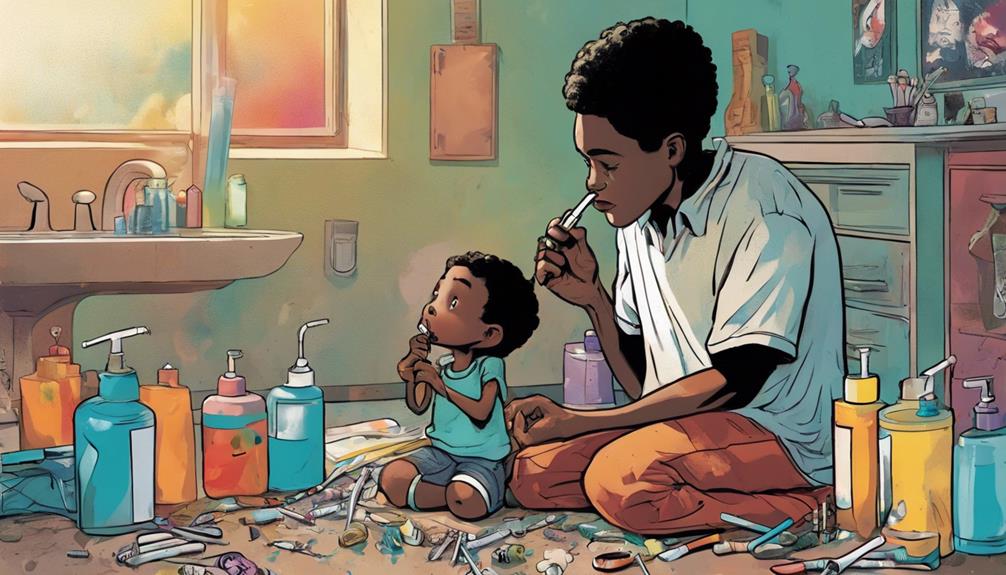
Discussing smoking with kids is essential, as it helps them understand the serious health risks associated with both secondhand and thirdhand smoke. Start by explaining that smoking isn't just a personal choice; it affects everyone around, especially children. Highlight that nearly 20% of U.S. adults smoke, making it a common issue they might encounter.
Talk about how smoking can harm oral health. Let them know that it can lead to stained teeth, bad breath, and an increased risk of cavities and gum disease. Explain that gum disease can cause serious problems, including tooth loss, which no kid wants to face. Smoking can have significant negative impacts on oral health. The chemicals in tobacco can stain teeth, leaving them yellow or brown. It can also lead to chronic bad breath, which can be off-putting to others. In addition, smoking can increase the risk of cavities and gum disease. The toxins in cigarettes can weaken the immune system, making it harder for the body to fight off infections in the mouth. Gum disease, in particular, can cause serious problems such as tooth loss, which no kid wants to face. To help combat these oral health issues, consider using an electric toothbrush benefits, which can provide a more thorough and effective cleaning compared to a manual toothbrush.
Encourage open conversations about peer pressure. Help kids recognize the addictive nature of nicotine and the importance of making healthy choices. Share stories or examples of how smoking impacts people's lives, particularly their health and appearance.
Resources for Support and Cessation
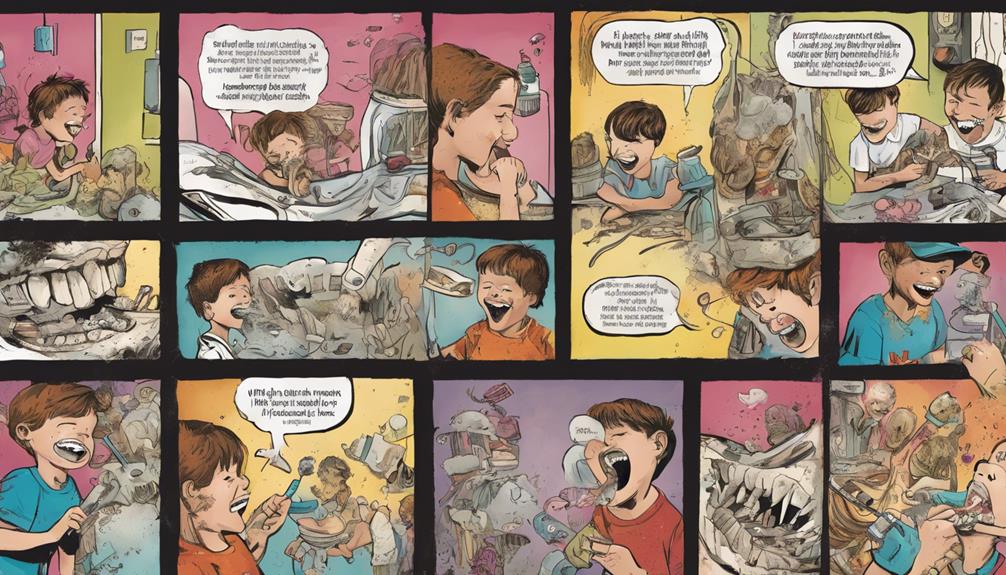
Accessing resources for support and cessation can make a significant difference in your journey to quit smoking and improve your oral health. It's crucial to utilize various support systems that can guide you through this challenging process.
Here are some valuable resources:
- Call the Quitline at 13 7848 (13 QUIT) for expert support and guidance on quitting smoking.
- Reach out to Dental Health Services Victoria at (03) 9341 1000 or 1800 833 039 for public dental services focused on oral health.
- Consult your doctor for personalized smoking cessation strategies tailored to your needs.
- Schedule an appointment with a dental hygienist to receive specialized oral care and advice if you're a smoker.
These resources can empower you to make informed decisions and stay on track.
Encouraging Healthy Choices

You can make a big difference by being a positive role model for kids when it comes to avoiding tobacco.
Show them fun alternatives to smoking, like engaging in sports or creative hobbies, to promote a healthier lifestyle.
Importance of Role Models
When adults model healthy choices, like avoiding smoking, they greatly shape children's attitudes toward tobacco use and overall well-being. When you demonstrate positive behaviors, you become a role model, influencing how children perceive smoking and its effects on their health.
Here are some key aspects of being an effective role model:
- Set a Good Example: Show that you prioritize your health and oral hygiene by avoiding smoking.
- Discuss Health Risks: Talk openly about how smoking affects not just the lungs but also dental health.
- Create a Smoke-Free Environment: Maintain your home and surroundings free from smoking, reducing exposure for children.
- Encourage Healthy Habits: Promote regular dental check-ups and proper oral hygiene to reinforce good health practices.
Fun Alternatives to Smoking
Finding fun alternatives to smoking can engage kids in healthier activities that promote their well-being and keep them away from tobacco. Encourage them to participate in sports or dance, which not only boost fitness but also build social connections that can deter smoking behavior. These activities help kids find joy in movement while fostering friendships.
Introduce creative hobbies like painting, music, or crafting. These fulfilling outlets can reduce stress and take their minds off any temptation to smoke. Providing opportunities for self-expression is essential in helping them cope with challenges.
Healthy snack alternatives, such as fruits and nuts, can satisfy cravings and improve their oral health compared to tobacco products. Snack time can become an enjoyable part of their day while reinforcing healthier choices.
Utilize technology by introducing kids to educational apps and games that illustrate the dangers of smoking and the benefits of a smoke-free lifestyle. Engaging kids through interactive learning can make a significant impact.
Lastly, promote team-building experiences like group volunteering or community projects. These activities instill a sense of purpose and belonging, further diminishing the allure of smoking.
Frequently Asked Questions
How Do You Explain to a Child About Smoking?
When explaining smoking to a child, focus on its harmful effects. You can say it makes teeth yellow, causes bad breath, and can lead to serious health issues, making it hard to smile and play.
What Is the Shocking Truth About Smoking?
Smoking's like a thief in the night; it silently steals health. The shocking truth is that it leads to serious diseases and dramatically increases your risk of cancer, affecting not just you but those around you.
What Are the Effects on Teeth From Smoking?
Smoking stains your teeth, causing yellow or brown discoloration. It increases your risk of gum disease and cavities, delays healing after dental work, and heightens the chances of serious oral health issues in the long run.
How Does Smoking Around Children Affect Them?
Did you know that kids exposed to secondhand smoke are 50% more likely to develop cavities? Smoking around children greatly increases their risk of dental issues, impacting both their oral health and overall well-being.
How Does Smoking Affect Kids’ Teeth and Oral Health?
Many parents wonder, “How many teeth kids will lose due to smoking?” Smoking can lead to tooth discoloration, gum disease, and even tooth loss in children. Secondhand smoke can also negatively impact kids’ oral health. It’s important for parents to promote a smoke-free environment to protect their children’s teeth and overall well-being.
Conclusion
In wrapping up, it's clear that the smoky haze of tobacco can cast a shadow over kids' dental health.
By fostering open conversations and encouraging healthy habits, you can help them navigate away from these harmful clouds.
Equip them with knowledge and support, steering them towards brighter, healthier smiles.
Remember, it's never too late to spark a change—together, you can create an environment where their teeth can shine without the burden of tobacco's influence.
